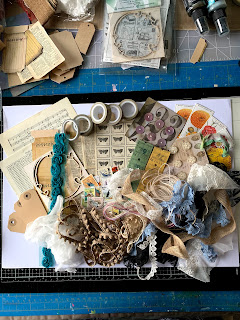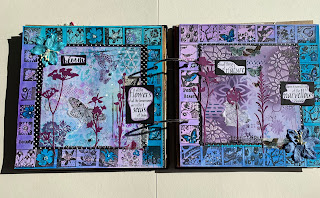Hi everyone. Gosh it’s a long time since my last blog but I wanted to post this evening as this will link to my article in this month’s edition of ‘Making Cards and Papercraft’ magazine. I’m so grateful to Sally Stirling and her team who allow me to contribute articles from time to time. This month I contributed a project that involved creating Vintage Collage cards. Collage is great fun but also a good way to use up all those left overs!
As you can see, I grab a host of stash and then select from it to fit each theme. So how did I get started?
As with most of my projects, I started by scraping some heavy white gesso through a few of my favourite stencils.
These were AALL & Create stencils! Once the raised gesso was dry, I used various Distress Oxide sprays to spray in different areas of the card. All the products I used are itemised in the magazine article so I don’t want to repeat it here. (www.makingcardsmagazine.co.uk) For the magazine I created four DL cards but in actual fact I made several small cards at the same time. I will use these for Thankyou Cards.
I generally waited for each colour to settle before adding more colours. I used three different, analogous colours on each card. I then let these dry naturally before I added any background stamping. Various background stamps were used around the edges mainly and avoiding any areas where I knew I’d be adhering collage items. I used complementary Distress Oxide ink pads to stamp with.
Once I’d decided on a theme for each card, I selected some stamp images to act as my main focus before selecting various items from my stash to complement them and trialled an arrangement to my liking on each card. For the first flat layers I just used a PVA glue but for the dimensional items I used silicone glue. This helped to raise them to create varied layers.
For the butterfly card I stamped the butterfly several times on vintage text pages. It involved quite a bit of fussy cutting but by layering them several times on top of each other creates a lovely textural effect for the wings.
As you can see from this particular card, the theme of butterflies dominates the selection of items. The base layer is a strip of Prima card which happened to have butterflies featured on it. It’s surprising how many items you can find in your stash that can relate to your theme once you start looking. I do hope this post has inspired you to collect items from your own stash to create some cards during this long period of us all self-isolating. Send a card to cheer someone up if you can! I can’t send these particular ones as I haven’t received them back yet but I did create some small ones that I posted as RAKs for some of my family and friends. However you are spending your closeted days, I do hope you can find time to craft. It’s great therapy! A close up of the others:
Hope you like them. I’d love to know if you popped by! Until next time!!

















































